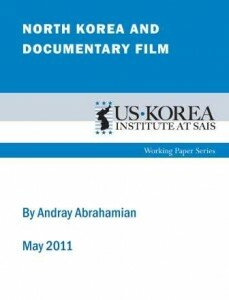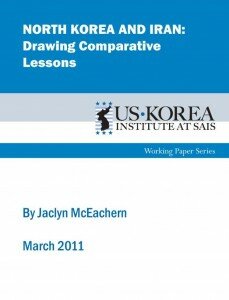Published on May 4, 2011
 Documentary film is a potent source of knowledge production, carrying assumptions of authority and sobriety. It offers the audience “reality,” even as it mediates heavily and imposes discursive judgments onto the subject matter. This subjectivity is especially problematic in documentary films about North Korea, as Western filmmakers find it difficult to escape wartime racism, anticommunist, and Orientalist frameworks, while at the same time the DPRK resists knowledge production about itself.
Documentary film is a potent source of knowledge production, carrying assumptions of authority and sobriety. It offers the audience “reality,” even as it mediates heavily and imposes discursive judgments onto the subject matter. This subjectivity is especially problematic in documentary films about North Korea, as Western filmmakers find it difficult to escape wartime racism, anticommunist, and Orientalist frameworks, while at the same time the DPRK resists knowledge production about itself.
This USKI Working Paper by Andray Abrahamian looks at four influential films–Welcome to North Korea, The Vice Guide to North Korea, A State of Mind, and North Korea: A Day in the Life–to examine how they cope with problems of subjectivity, bias, and representing reality. Download the paper here.
Published on March 7, 2011
 In a new USKI Working Paper, Jaclyn McEachern examines the analogies that have been drawn between North Korea and Iran, to help identify the limitations of each when trying to inform policy preferences. In doing so, she identifies four areas in which lessons can be extracted and applied in a cross-context setting. Download the paper here.
In a new USKI Working Paper, Jaclyn McEachern examines the analogies that have been drawn between North Korea and Iran, to help identify the limitations of each when trying to inform policy preferences. In doing so, she identifies four areas in which lessons can be extracted and applied in a cross-context setting. Download the paper here.
Published on September 29, 2010
 On October 18, 2010, at 6pm, the U.S.-Korea Institute and the Korea Studies Program at SAIS are pleased to host a screening and discussion of Deann Borshay Liem’s latest documentary, In the Matter of Cha Jung Hee, at the Kenney Auditorium (1740 Massachusetts Ave., NW, Washington, DC 20036) at SAIS.
On October 18, 2010, at 6pm, the U.S.-Korea Institute and the Korea Studies Program at SAIS are pleased to host a screening and discussion of Deann Borshay Liem’s latest documentary, In the Matter of Cha Jung Hee, at the Kenney Auditorium (1740 Massachusetts Ave., NW, Washington, DC 20036) at SAIS.
Her passport said she was Cha Jung Hee. She knew she was not. So began a 40-year deception for a Korean adoptee who came to the United States in 1966. Told to keep her true identity a secret from her new American family, this eight-year-old girl quickly forgot she was ever anyone else. But why had her identity been switched? And who was the real Cha Jung Hee? read more …
Published on February 16, 2010
 In this Working Paper, Joel S. Wit, USKI Visiting Scholar and former State Department official, assesses North Korea’s nuclear future by discussing the four most probable scenarios.
In this Working Paper, Joel S. Wit, USKI Visiting Scholar and former State Department official, assesses North Korea’s nuclear future by discussing the four most probable scenarios.
Each scenario is analyzed according to a number of factors including the implications for: 1) U.S. political, security and other interests in the region; 2) the same interests for Japan and the Republic of Korea; 3) North Korea, particularly its security relations with the international community and domestic situation; 4) other key surrounding countries, particularly China; 5) peace and stability in Northeast Asia; and 6) the international non-proliferation regime.
Working Paper Series: Four Scenarios for a Nuclear North Korea
Published on October 10, 2009
WPS 09-07: Economic Cooperation between South Korea and Kazakhstan, by Lee Jae-young (October 2009). As 97 percent of South Korean energy comes from imports, Central Asia is a very important area for developing and securing foreign energy resources. Among the countries in Central Asia, Kazakhstan has shown the highest tangible economic development results. Moreover, Kazakhstan, compared to other Central Asian countries, has the richest natural resources, a superior economy size, and a relatively stable political situation that could increase the speed of political modernization. Kazakhstan is also leading the region in terms of market reforms. In this paper, Dr. Lee examines the status of economic cooperation between South Korea and Kazakhstan and suggests basic policies to improve relations between the two countries.
Published on October 3, 2009
WPS 09-09:  The Origins of Korean Adoption: Cold War Geopolitics and Intimate Diplomacy, by Eleana Kim, Ph.D. (October 2009). The adoption of children from South Korea to the West has been ongoing since the end of the Korean War in 1953. During the past half century, more than 200,000 children have been adopted into predominantly white families in Western Europe, North America, and Australia. In this paper, Eleana Kim, examines the origins of Korean adoption in the immediate postwar period, showing how the first adoptions of Korean boys by American servicemen gave way to the adoptions of mixed-race, and then full-Korean children into nuclear families. She elaborates on the little-known history of Korean transnational adoption to understand more fully how particular “technologies of intimacy,” including those related to legislation, transportation, communications, and especially mass media and financial sponsorships, facilitated the transfer of children from Korea to the U.S., and how these technologies were informed by and reproduced paternalistic relations between Americans and Koreans in the context of the Cold War.
The Origins of Korean Adoption: Cold War Geopolitics and Intimate Diplomacy, by Eleana Kim, Ph.D. (October 2009). The adoption of children from South Korea to the West has been ongoing since the end of the Korean War in 1953. During the past half century, more than 200,000 children have been adopted into predominantly white families in Western Europe, North America, and Australia. In this paper, Eleana Kim, examines the origins of Korean adoption in the immediate postwar period, showing how the first adoptions of Korean boys by American servicemen gave way to the adoptions of mixed-race, and then full-Korean children into nuclear families. She elaborates on the little-known history of Korean transnational adoption to understand more fully how particular “technologies of intimacy,” including those related to legislation, transportation, communications, and especially mass media and financial sponsorships, facilitated the transfer of children from Korea to the U.S., and how these technologies were informed by and reproduced paternalistic relations between Americans and Koreans in the context of the Cold War.
Published on August 10, 2009
WPS 09-05: Myanmar-South Korean Economic Cooperation: Prospects and Strategies, by Chang-Yeon Kim (August 2009). Myanmar was the wealthiest country in Southeast Asia until the early 1960s but is now one of the poorest nations in the world. However, given its rich natural resource endowment as well as its key geostrategic position in Asia, Myanmar has the potential to rise to power once again. South Korean entrepreneurs have been investing in Myanmar’s resource extraction industries since 1990, and the South Korean government has been providing ODA to Myanmar since 1991. Although trade volume between Myanmar and South Korea is increasing, the full potential of Myanmar’s strategic value has yet to be acknowledged. In this paper, Mr. Kim analyzes the current status of Myanmar’s economy and its economic cooperation with South Korea, and discusses the potential benefits that could result from increased cooperation.
 Documentary film is a potent source of knowledge production, carrying assumptions of authority and sobriety. It offers the audience “reality,” even as it mediates heavily and imposes discursive judgments onto the subject matter. This subjectivity is especially problematic in documentary films about North Korea, as Western filmmakers find it difficult to escape wartime racism, anticommunist, and Orientalist frameworks, while at the same time the DPRK resists knowledge production about itself.
Documentary film is a potent source of knowledge production, carrying assumptions of authority and sobriety. It offers the audience “reality,” even as it mediates heavily and imposes discursive judgments onto the subject matter. This subjectivity is especially problematic in documentary films about North Korea, as Western filmmakers find it difficult to escape wartime racism, anticommunist, and Orientalist frameworks, while at the same time the DPRK resists knowledge production about itself.




